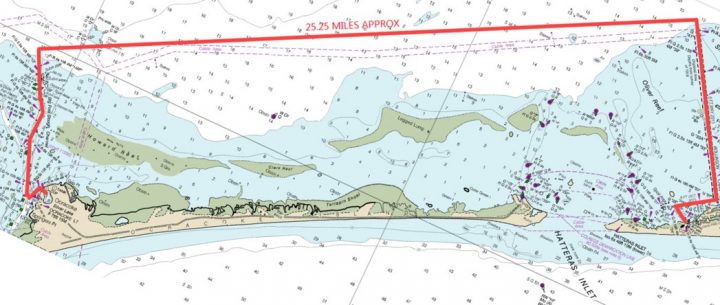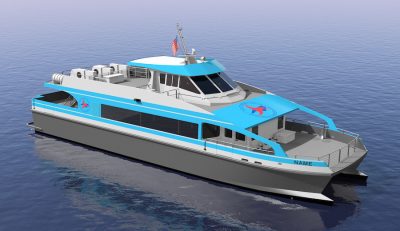
Reprinted from Island Free Press
MANTEO — The Ocracoke Express, the state’s first high-speed passenger ferry, could provide a different kind of tourism adventure for Outer Banks visitors by next summer. But first, it has to be figured out how to divert passengers from long lines of traffic to board the boat, and then readily get them around Ocracoke when they disembark.
Supporter Spotlight

Adequate parking, public awareness and plenty of good information are also critical elements to the success of the new ferry service planned between Hatteras and Ocracoke islands.
That was the consensus of more than three dozen members of the North Carolina Department of Transportation Ferry Division’s passenger ferry steering committee that met for the first time last week to work out myriad details of a proposed plan to supplement vehicle ferry transportation with a passenger ferry from May to September.
“I want to make one thing clear: We want your input,” Jed Dixon, the deputy director of the Ferry Division told the committee, which has a total membership of 48 stakeholders. “There’s nothing set in stone here.”
Crammed around a table in the meeting room at the Outer Banks Visitors Bureau office in Manteo, the committee representing business, government, tourism and community interests on both islands listened to a Ferry Division presentation about the passenger ferry project and operation.
Overall, their response was upbeat and enthusiastic about it being a positive evolution for Outer Banks tourism.
Supporter Spotlight
“This has been such a huge project for Hyde County,” said Hyde County Manager Bill Rich, adding that the county expects to garner $4 million a year in revenue from the passenger ferry. “It’s just big, big, big … great things, I think, are going to happen.”
Hyde County is still working out its plan for operating the four trams that will be provided to transport passengers around the island on the eight-stop, 3-mile loop, he said.
As everyone on both islands knows, dramatic changes in Hatteras Inlet in recent years have had a negative effect on ferry travel. A rapid increase in shoaling started after Hurricane Isabel in 2003, and worsened in subsequent storms. At the same time, the ends of both islands, especially Hatteras, have eroded. In 1984, the inlet was a quarter-mile wide; in 2016 it was about 2 miles wide.

“It’s changing at a staggering rate,” Dixon said, “and there’s really no sign of the trend changing at all.”
By 2012, ferry traffic had to be rerouted from the former straight-shot, 4.3-mile channel to the current U-shaped channel that is 9.5 miles long. As a consequence, the one-way trip between the Hatteras and Ocracoke ferry docks takes an hour rather than 40 minutes, and fuel cost about $250,000 more a month.
And longer trips mean fewer trips. Daily departures on each side have been cut from about 52 to 42, resulting in longer lines of vehicles waiting to get on a ferry.
About 20 percent of would-be passengers – 61,600 – turn around and leave, translating to significant business losses on Ocracoke. A single passenger ferry could meet that demand with four round trips a day. The $15 round-trip fare would also generate $924,000 in annual revenue.
Dixon said that the original plan for two passenger ferries had to be scaled back because of funding.
“This kind of gives us a start,” he said.
In response to a question about why passengers can’t buy one-way fare to encourage overnight stays, Dixon explained that it’s mostly because long-term parking provisions are not yet available.
So far, the plan calls for about 140 parking spaces in Hatteras in the vicinity of the ferry docks. Although a survey showed that the majority of visitors to the island are day-trippers, he said, it is still an issue that the division plans to address.
If a breakdown were to make the passenger ferry unavailable, Dixon said affected passengers would be able to walk onto a vehicle ferry and sit in the lounge. He added that the high-speed ferry is subject to the same limitations in bad weather as the vehicular ferries.
Joseph Schwarzer, director of the North Carolina Maritime Museums, which includes the Graveyard of the Atlantic Museum across from the ferry docks, said he had concerns about ferry passengers being caught in traffic.
“The point is to alleviate congestion on Hatteras Island,” Schwarzer said about the extra ferry. “But it’s not going to.”
Schwarzer was skeptical that a shuttle service could be a solution, since vehicles can back up long before they reach the stacking lanes. “They can’t get there,” he said. “You’re going to be stuck trying to get to the passenger ferry.”
But Dixon expressed confidence that the issue can be addressed with a combination of good signage, redirecting traffic and shuttles. But he warned the committee that there will be complications as the new service gets underway.
“I’ll be completely honest – we’re not going to know all these things from the start,” he said. “We can’t forward-think everything. But once we have a problem, we’ve got to identify it and figure out how to fix it.”
For that reason, it would be wise to have a “soft release” and not promise visitors too much out of the gate, said Chip Stevens, an owner of Blackbeard’s Lodge, a hotel on Ocracoke Island.
“Let them understand that they’re part of making this happen,” he said.
It is important to make the passenger ferry an enjoyable visitor experience, from parking their car in Hatteras, to enjoying drinks and snacks on the ferry, to bopping around Ocracoke on the tram, the committee agreed.
The Ocracoke Express, the name chosen by area students, will have a cruising speed of about 30 knots, compared with the average 10-knot speed of vehicular ferries, and will take about an hour and five minutes each way, dock to dock.
The 24-mile route will bypass the problematic part of the inlet environment. It will dock at new floating docks in Silver Lake Harbor at Ocracoke and Hatteras Village, and both sides will have new covered passenger shelters.
Manufactured by U.S. Workboats, the two-deck aluminum catamaran will carry 96 passengers and have two wheelchair spaces, bike racks and a snack bar. The vessel is expected to be delivered to the division on June 6, followed by testing, trials and training, and should be ready for operation in mid-summer.
The terminal improvements project had been put out to bid, Dixon said, but because only one company responded, it must be re-bid. The passenger ticketing is targeted to be available online by mid-April.
In a later email, Dixon provided a breakdown of the roughly $9 million project costs, which are as follows:
- Passenger ferry: $4.5 million.
- Engineering, architectural and environmental permitting: $2.1 million.
- Hatteras and Ocracoke terminals and docks: $2.3 million.
- Ocracoke transit: $170,000.
Of that total, the General Assembly appropriated $3.6 million and $5.4 million was covered by a Federal Land Access Program grant.

As a bold upgrade in transportation options for tourists, the state sees opportunity for future partnerships with other coastal areas, Ferry Division Director Harold Thomas said.
“We want to promote this the best we can,” Thomas said.
To Danny Couch, a committee member who also represents Hatteras Island on the Dare County Board of Commissioners, the passenger ferry is a great way to illustrate how “inseparable” the islands and their unique assets are in Outer Banks identity.
“You’ve got the ability now to maximize what has sold us,” he said. “We’re going to get $2 for our $1 by working together.”
The next bi-monthly meeting of the passenger ferry committee will be held in December.
Learn More
This story is provided courtesy of the Island Free Press, a digital newspaper covering Hatteras and Ocracoke islands. Coastal Review Online is partnering with the Free Press to provide readers with more environmental and lifestyle stories of interest along our coast. You can read other stories about Hatteras and Ocracoke here.








